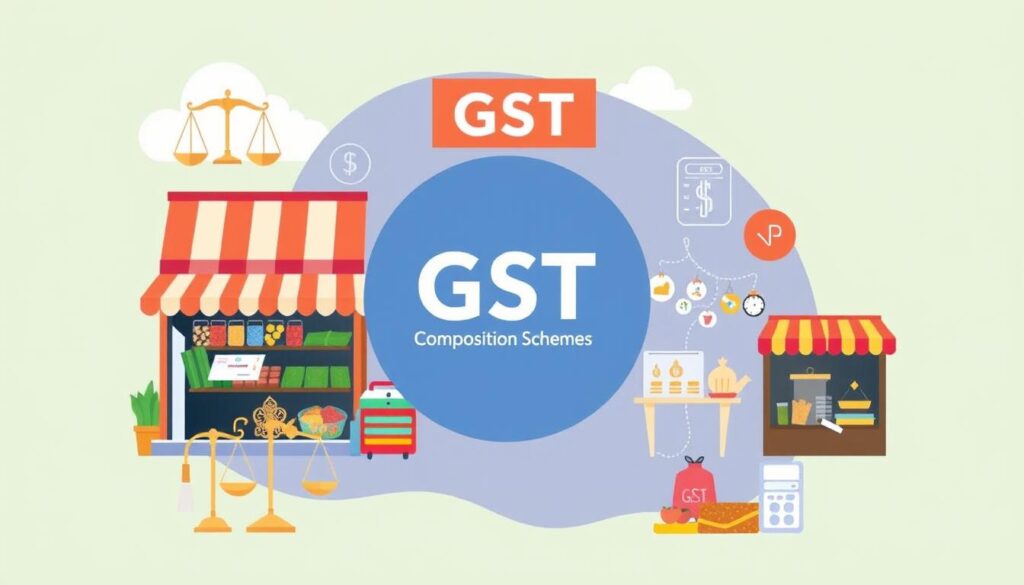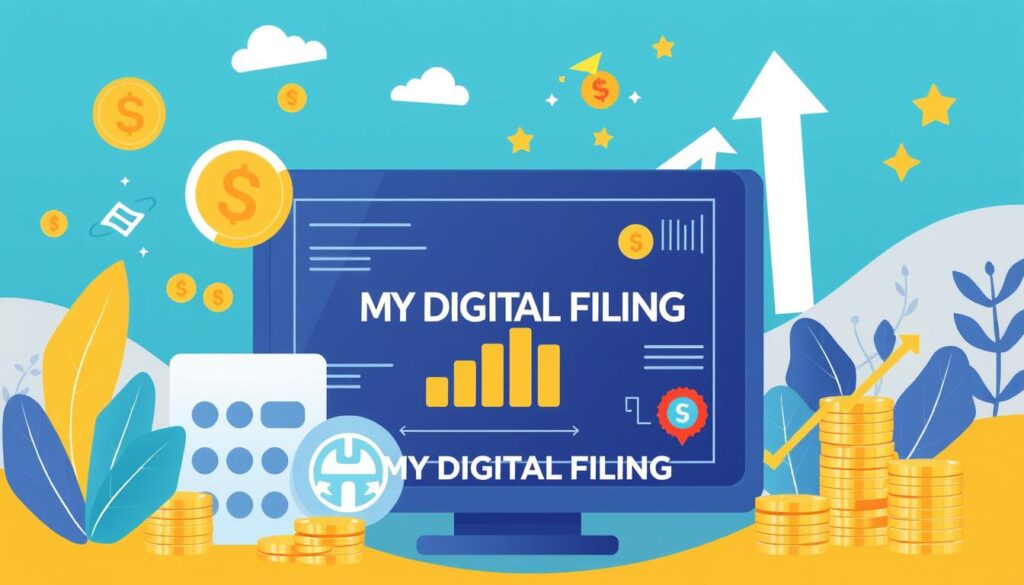Did you know India’s e-commerce market is expected to reach US$99 billion by 2024? This makes India the second-largest e-commerce market, just behind the US. As the digital market grows, so does the need for tax compliance. The GST registration process for e-commerce operators is now essential for legal and smooth business operations.
The Central Board of Excise & Customs (CBEC) has set up special rules for e-commerce GST registration. This is because the sector is growing fast and has complex tax issues. If you sell online or plan to start an e-commerce business, knowing these rules is crucial for your success.
Now, e-commerce business tax compliance is a must. Section 24 of the Central Goods and Services Tax Act, 2017 requires all e-commerce operators to register for GST. This includes collecting a 1% tax on each transaction, except for exempted goods and services.
As an e-commerce operator, you must collect Tax Collected at Source (TCS) at a maximum rate of 1% on the net value of taxable goods or services. This ensures the government can track transactions and prevent tax evasion in the digital marketplace.
Key Takeaways
- India’s e-commerce market is projected to reach $99 billion by 2024
- GST registration is mandatory for all e-commerce operators
- 1% TCS must be collected on taxable transactions
- Registration is required regardless of turnover
- Specific provisions exist for foreign e-commerce operators
- GST registration offers benefits like input tax credit and market access
Understanding GST for E-commerce in India
E-commerce in India is booming, with a market size expected to hit $99 billion by 2024. This growth introduces new taxation rules for businesses. Let’s dive into the main points of GST for e-commerce in India.
Definition of E-commerce under GST
The CGST Act defines e-commerce as selling goods or services online. An Electronic Commerce Operator (ECO) is anyone who runs an online store.
GST Provisions for E-commerce Operators
E-commerce marketplaces have strict GST rules. All sellers must register for GST, no matter their sales volume. ECOs must collect and pay 1% tax (0.5% CGST and 0.5% SGST) on each sale.
Digital Goods GST Regulations
Digital goods sellers face special challenges. The GST rate for digital items like e-books depends on where the buyer is. This location decides the IGST rate.
“E-commerce operators are responsible for collecting GST and TCS from sellers and discharging the tax liabilities.”
Key points to remember:
- Commission charged by ECOs falls under HSN code 9985, with an 18% GST rate
- TCS at 0.5% is deducted on payments made to sellers
- Sellers must file GST returns like GSTR-1, GSTR-3B, and GSTR-9/9C
- Invoicing requirements include supplier details, HSN codes, and GST rates
It’s vital for digital businesses to grasp these taxation rules. Following them ensures smooth operations and avoids GST penalties.
Goods and Services Tax (GST) Basics
GST is at the heart of India’s tax system. It replaces many indirect taxes, making things simpler and uniting the national market. Let’s explore the main points of GST.
Indirect Destination-Based Tax
GST is an indirect tax system based on where goods and services are used. It’s collected at the final point of use. This way, the tax benefits the state where the product or service is used.
For e-commerce sites, GST registration is needed under Section 24 of the CGST Act. They must collect and pay 1% tax on each sale, as Section 52 of the CGST Act states. This rule is for all online businesses, making it key to know their tax duties.
Multi-Stage Comprehensive Tax
GST is charged at every step in the supply chain. This multi-stage method makes tax collection more efficient. Here’s how it works:
| Stage | Action | Tax Implication |
|---|---|---|
| Manufacturing | Production of goods | GST applied on raw materials |
| Wholesaling | Bulk purchase from manufacturer | GST on wholesale price |
| Retailing | Sale to end consumer | Final GST on retail price |
Businesses can claim back taxes paid at earlier stages. This means the final buyer pays the tax. For e-commerce sites, knowing this is crucial for following rules and running smoothly in India.
Eligibility Criteria for GST Registration
GST registration is key for e-commerce in India. All online sellers must register, no matter their sales. This rule comes from Section 24 of the Central Goods and Service Tax Act, 2017.
Businesses with over Rs. 20 lakh in annual sales need to register. In northeastern states, it’s Rs. 10 lakh. E-commerce sites must also register if they sell across states.
E-commerce sites must collect Tax Collection at Source (TCS) at 1% for online sales. Non-resident e-commerce providers selling to Indians must also register for GST.
| Category | GST Registration Requirement |
|---|---|
| E-commerce Operators | Mandatory, regardless of turnover |
| Regular Businesses | Turnover > Rs. 20 lakh (Rs. 10 lakh for NE states) |
| Inter-state Suppliers | Mandatory, irrespective of turnover |
| TCS Collectors | Mandatory |
| Non-resident Operators | Mandatory for services to Indian individuals |
The Union Budget 2024 made changes to GST rules, starting October 1st, 2023. Since January 1st, 2022, e-commerce sites like Zomato and Swiggy pay a 5% GST rate.
Knowing GST rules is vital for e-commerce to stay compliant and avoid fines. These rules help the government collect taxes better in the fast-growing e-commerce world.
Tax Collected at Source (TCS) under GST
E-commerce operators have a big role in GST TCS compliance. They help collect taxes, making the financial system clear. Let’s look at what they do and the TCS rates.
Responsibility of E-commerce Operators
E-commerce operators must collect and deposit TCS for each sale on their site. This rule applies to all sales, big or small. They must also register for GST, as the law says in Section 24(x) of the CGST Act, 2017.
“E-commerce operators are the custodians of TCS, ensuring its timely collection and deposit to maintain a healthy tax ecosystem.”
TCS Rate and Applicability
The TCS rate for e-commerce operators is 1% of the total taxable sales. This includes 0.5% CGST and 0.5% SGST for sales within the state. For sales across states, it’s 1% IGST. The total value is the monthly sales minus any returns.
| Tax Component | Rate | Applicability |
|---|---|---|
| CGST | 0.5% | Intra-state transactions |
| SGST | 0.5% | Intra-state transactions |
| IGST | 1% | Inter-state transactions |
Operators must pay the TCS by the 10th of the next month. They need to file a monthly TCS return (GSTR-8) and an annual return (GSTR-9B) by December 31st after each year. Not following these rules can lead to fines and interest.
It’s key for e-commerce operators to know and follow TCS rules. This helps them stay in line with GST and avoid legal trouble.
Tax Deducted at Source (TDS) under GST
GST TDS is key for e-commerce tax deductions in India. The government takes 2% TDS (1% CGST + 1% SGST or 2% IGST) from payments to sellers. This rule kicks in when the total supply value is over Rs 2.5 lakhs.
E-commerce operators need to know about TDS for online businesses. The registration process for tax collectors is vital for correct implementation. TDS in GST promotes tax compliance, especially in sectors like construction.
The Indian government awards over 10,000 civil contracts yearly. National highway contracts often exceed Rs. 100 crores. This affects big construction firms and many subcontractors. TDS ensures tax clarity and compliance in these areas.
For e-commerce operators, TDS compliance has brought changes and higher costs. Big names like Flipkart, Snapdeal, and Amazon have had to update their systems. TDS regulations under GST aim to fight tax evasion and boost tax rules in India.
| Type | Rate | Threshold |
|---|---|---|
| TDS | 2% (1% CGST + 1% SGST or 2% IGST) | Supply value > Rs 2.5 lakhs |
| TCS for E-commerce | 1% (0.5% CGST + 0.5% SGST or 1% IGST) | All transactions |
Knowing these TDS rules is crucial for e-commerce operators to stay compliant and avoid fines. Keep up with the latest GST rules to run a smooth business in India’s growing e-commerce market.
Who Will Collect TCS Under GST?
E-commerce operators are responsible for collecting TCS under GST. Since October 1, 2018, they have been collecting Tax Collected at Source (TCS) on transactions. This is a key part of GST compliance for online platforms.
The TCS rate is 0.5% of the net taxable supplies, as stated in CGST Notification 15/2024. E-commerce operators must collect this tax when paying vendors. This helps strengthen tax regulation and reduce evasion in the digital economy.
E-commerce tax obligations go beyond just collection. Operators must:
- Register for GST in each state of operation
- Deposit TCS within 10 days from the month-end of supply
- File GSTR-8 by the 10th of the following month
These steps ensure timely tax deposits and keep online transactions transparent. For sellers, GST registration is required when selling through e-commerce platforms, no matter the turnover.
TCS under GST plays a crucial role in enhancing compliance and streamlining tax administration in the e-commerce sector.
The introduction of TCS has big implications for the e-commerce world. It requires financial and operational changes, like using ERP systems for compliance. While it might affect working capital for some sellers, it makes the online marketplace more regulated and transparent.
How to Register GST for an E-commerce Operator?
E-commerce operators in India must register for GST to follow tax rules. The GST registration steps for e-commerce businesses are easy and done online. We will look at the e-commerce GST application process and what documents you need.
Step-by-Step Guide
The online GST registration process for e-commerce operators has these main steps:
- Visit the official GST portal at gst.gov.in
- Click on ‘Services’ and select ‘Registration’
- Choose ‘New Registration’ and pick your business category
- Fill in your details and upload necessary documents
- Submit the application and receive your ARN
Required Documents
To finish your e-commerce GST application, you’ll need:
- PAN card
- Aadhaar card linked to mobile number
- Passport-sized photograph
- Business address proof
- Bank account statements
- Legal business name
- Email address and mobile number
Online Registration Process
The online GST registration process is quick and doesn’t need paper. After applying, you’ll get an Application Reference Number (ARN) via SMS and email. The registration certificate usually comes in 3-5 days. Remember, e-commerce operators must register for GST, even if they don’t meet the turnover limit, as Section 24 of the CGST Act says so.
| Registration Aspect | Detail |
|---|---|
| Time to Receive Certificate | 3-5 days |
| Turnover Limit for Registration | No limit (Mandatory) |
| Registration Deadline | Within 30 days of starting business |
| GST Rate on E-commerce Commission | 18% |
By following these GST registration steps, e-commerce operators can make sure they follow Indian tax laws. This way, they can keep their business running smoothly.
GST Registration Rules for Those Liable to TCS
E-commerce operators have specific rules for GST registration. These rules help ensure everyone follows the rules and makes tax collection easier online.
Mandatory Registration Irrespective of Turnover
All e-commerce operators must register for GST, no matter their sales. This rule is for all online sellers. It shows how important it is to follow the rules in the digital world.
To register, you need to fill out Form GST REG-07 online. You can use a Digital Signature Certificate (DSC) or Electronic Verification Code (EVC) to sign it.
Obligations of Registered E-commerce Operators
After registering, e-commerce operators have to do several things:
- Collect TCS at 1% (0.5% CGST + 0.5% SGST) for sales within the state
- Collect 1% IGST for sales across states
- File GSTR-8 returns by the 10th of the next month
- Report all sales made through their platform
- Make sure to pay the collected TCS on time
| Aspect | Requirement |
|---|---|
| TCS Rate | 1% (0.5% CGST + 0.5% SGST/IGST) |
| Return Filing | GSTR-8 by 10th of next month |
| Payment Mode | Electronic Cash Ledger only |
| Authentication | DSC or EVC |
E-commerce GST obligations are more than just registration. Operators must keep accurate records and help with tax collection. They also need to follow new rules as they come. By following these rules, online sellers help make the digital marketplace fair and efficient.
GST Registration for People Supplying Online Information from Outside India
For businesses sending online info from outside India, GST rules are key. The Goods and Services Tax (GST) in India needs special registration for these providers.
Applicability to OIDAR Service Providers
OIDAR services, like online data access, need GST registration if sent to India. These services use the internet or electronic networks.
OIDAR services tax hits providers with over Rs. 20 lakhs turnover. E-commerce services from abroad must also register.
Examples of OIDAR Services
International digital services GST includes many types. Here’s a list of common OIDAR services:
| Service Category | Examples |
|---|---|
| Digital Content | E-books, movies, music, software |
| Cloud Services | Data storage, software-as-a-service |
| Online Advertising | Internet ads, digital marketing |
| Web-based Services | Trade statistics, legal and financial data |
| Online Gaming | Multiplayer games, gaming platforms |
OIDAR providers must sign up for GST with the REG-10 form on the common portal. The sign-up follows rules set by the Central Government and the GST Council.
Knowing these rules is vital for following Indian tax laws. It helps meet tax duties in cross-border digital services.
GST Registration Process for OIDAR Service Providers
OIDAR GST registration is key for digital service providers in India. It makes sure you follow e-commerce tax laws. If your yearly sales hit Rs.20 lakh (or Rs.40 lakh/Rs.10 lakh, based on state and supply type), you must register for GST.
The registration is done online at gst.gov.in. You’ll need to fill out a form with your business and operations details. After validation, you get a 15-digit Temporary Reference Number (TRN).
- The OTP for mobile verification is valid for only 15 minutes
- You have 15 days to submit your application after generating the TRN
- Required documents include PAN card, bank account details, and address proof
E-commerce sites must collect Tax Collection at Source (TCS) under GST. They must register, no matter their sales. Approval for e-commerce operators under TCS rules comes in 3 working days.
OIDAR services include online advertising, cloud services, digital content, web-based services, and online gaming.
After registering, you must follow GST rules. This means proper invoicing, filing returns, and following tax rates. Not following these can lead to penalties of Rs. 10,000 or the tax amount, whichever is higher.
| Service Type | GST Registration Requirement |
|---|---|
| E-commerce Operators | Mandatory, regardless of turnover |
| OIDAR Service Providers | Mandatory if turnover exceeds threshold |
| Online Sellers | Mandatory to claim tax collected by aggregators |
By following these steps, you’ll fit well into the GST system for digital services across borders.
Conclusion
GST registration is key for e-commerce in India. The online retail market is growing fast, set to hit US$ 325 billion by 2030. This shows how crucial e-commerce GST compliance is. As an e-commerce operator, you must understand the complex tax rules to run smoothly.
The GST has made tax rules simpler for e-commerce businesses. Now, most goods and services have a uniform 18% tax rate. This has made things easier and more consistent. The Tax Collected at Source (TCS) at 1% on net taxable supplies has also helped strengthen the tax system for online sales.
It’s important to remember that GST registration is a must for all e-commerce operators, no matter the turnover. You need to register in each state or union territory where you have suppliers. The online GST portal makes it easy to register, file returns, and manage taxes, highlighting the importance of GST registration today.
Following GST rules helps formalize e-commerce in India. This not only keeps your business legal but also lets you claim Input Tax Credit benefits. This can lower your tax bill. Keep up with the latest GST news to stay ahead in the changing e-commerce world.
FAQ
Q: How to register GST for an e-commerce operator?
A: To register for GST as an e-commerce operator, start online. Go to gst.gov.in and click on ‘Services’ then ‘Registration’. Choose ‘New Registration’ and pick your category. Enter your details and upload documents.
After submitting, you’ll get an Application Reference Number (ARN).
Q: What is the definition of e-commerce under GST?
A: Section 2(44) of the CGST Act, 2017, defines e-commerce. It’s about selling goods or services online. An Electronic Commerce Operator (ECO) is anyone who runs an online store or platform.
Q: What is the growth outlook for the e-commerce market in India?
A: The Indian e-commerce market is growing fast. It’s expected to hit USD 99 billion by 2024. Big names like Google and Facebook are investing heavily.
Q: What are the specific GST provisions for e-commerce operators?
A: E-commerce operators must collect 1% tax on each sale. This includes 0.5% CGST and 0.5% SGST. They also need to follow GST rules, like filing returns and keeping records.
Q: What is the purpose of GST?
A: GST is a tax on goods and services at the point of sale. It’s a single tax that replaces many old taxes. It aims to simplify taxes and unite the national market.
Q: Who is required to register for GST in the e-commerce sector?
A: All online sellers must register for GST, no matter their sales. But, those earning less than Rs. 20 lakhs and not using an e-commerce platform are exempt.
Q: What is the responsibility of e-commerce operators regarding Tax Collected at Source (TCS) under GST?
A: E-commerce aggregators must collect 1% tax on each sale. This includes 0.5% CGST and 0.5% SGST. The tax is taken from the seller’s payment.
Q: What is Tax Deducted at Source (TDS) under GST, and how does it apply to e-commerce operators?
A: TDS is a tax deducted before payment to suppliers. It’s 2% (1% CGST + 1% SGST) for transactions over ₹2,50,000. E-commerce operators need to know about TDS, especially for big transactions.
Q: Who will collect TCS under GST?
A: E-commerce aggregators collect TCS under GST. All online sellers must register for GST, even if their sales are low. This lets them claim the tax collected by aggregators.
Q: What are the steps to register for GST as an e-commerce operator?
A: To register, visit gst.gov.in. Go to ‘Services’, then ‘Registration’, and choose ‘New Registration’. Pick your category and enter your details and documents.
Upload the required documents and get an Application Reference Number (ARN) after submitting.
Q: What are the GST registration rules for those liable to collect TCS?
A: E-commerce operators must register for GST if they collect TCS. They need to apply online using Form GST REG-07. They must collect TCS, file returns, and follow GST rules.
Q: Do online information and database access or retrieval (OIDAR) service providers from outside India need to register for GST?
A: Yes, OIDAR service providers from outside India must register for GST. Budget 2023 says OIDAR includes services like online advertising, cloud services, and e-books.
Q: What is the process for GST registration for OIDAR service providers?
A: OIDAR service providers need to register if their annual sales are over Rs.20 lakh. The process is online at gst.gov.in. Fill out a form with your service details and business information.










